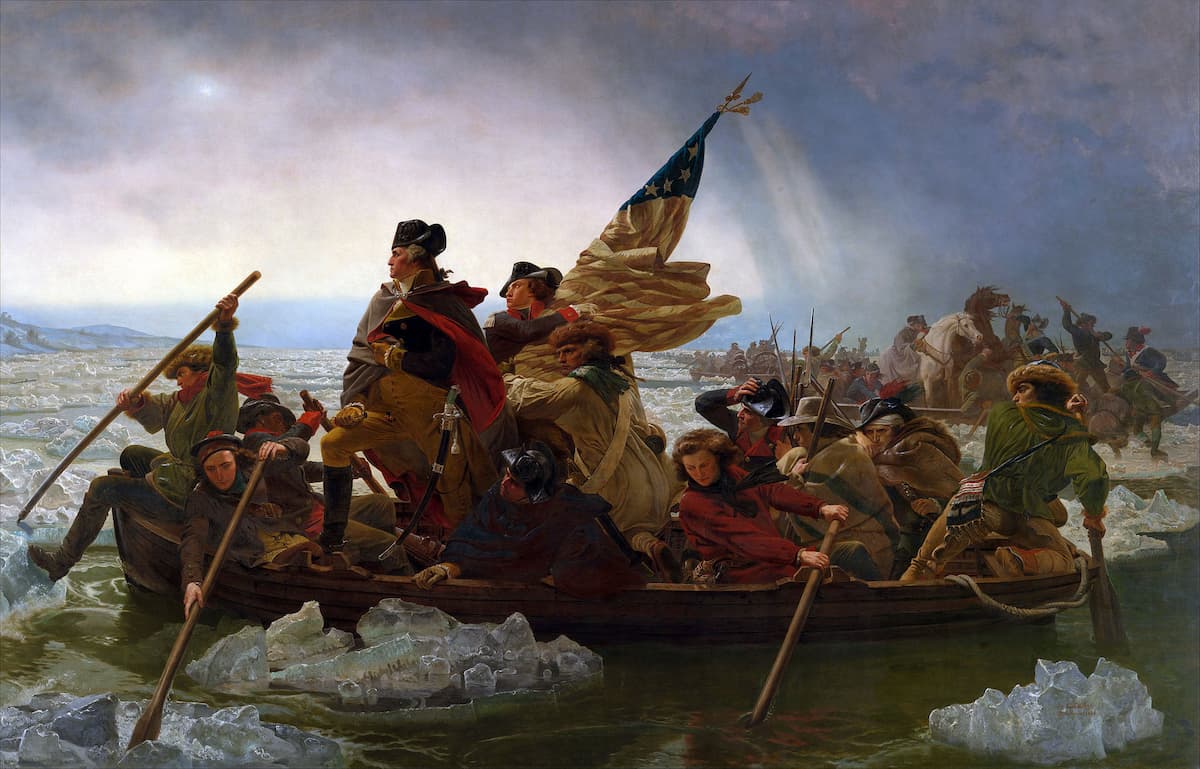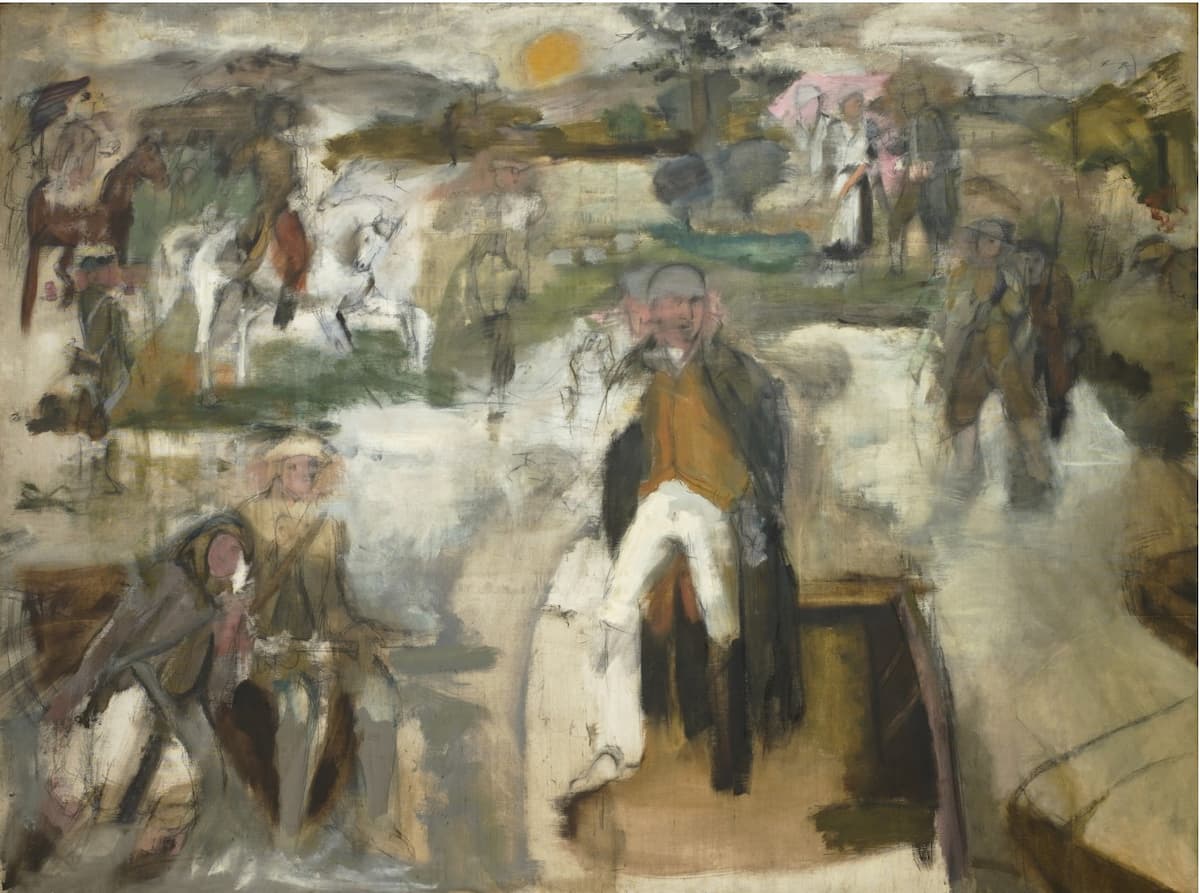Poetry and Music Inspired by “Washington Crossing the Delaware”
In 1953, the New York painter Larry Rivers, considered the either Godfather or Grandfather of Pop art, took up an All-American subject, General George Washington’s crossing of the Delaware. To most Americans, the image they know is from the German painter Emanuel Leutze’s 1851 picture.

Emanuel Leutze: Washington Crossing the Delaware, 1851 (Metropolitan Museum)
Shown as on Christmas night, 1776, Washington is bringing his troops across the ice-bound Delaware River for a surprise attack and defeat of the British at the Battle of Trenton. The painting is enormous (378.5 cm × 647.7 cm (149 in × 255 in)). The copy at the Metropolitan Museum is a contemporary full-sized replica of the original, which was held by the Kunsthalle Bremen until it was destroyed during WWII. Leutze had painted the work as inspiration to the European reformers of 1848 to look to the Americas and Washington’s victories for examples of revolutions that succeeded.
Larry Rivers’ version is from a very different angle in several ways.

Larry Rivers: Washington Crossing the Delaware, 1953 (New York: Museum of Modern Art)
There’s a boat, there’s a river, and soldiers; the central figure commands the situation. Rivers, inspired by reading Tolstoy’s War and Peace in 1953, said in his autobiography ‘I chose to paint the crossing at the moment before it became a complex military operation. I saw…. Washington shouting over the confusion in the center…standing in a rocking boat, getting men, food munitions, and spirit across the river.’ All sorts of imagery were used by Rivers in the work, taking Washington’s head from a Leonard da Vinci drawing of a screaming man, the clothes came from a memory of a body by Jacques Louis David, and the soldiers came from children’s books about revolutionary war soldiers. He didn’t base it on the Leuze painting because he had only seen it ‘once or twice and had never viewed it at any length or with any passion.’

Larry Rivers (left) and Frank O’Hara (right)
His lover, the poet Frank O’Hara, wrote a poem about the work: ‘On Seeing Larry Rivers’ “Washington Crossing the Delaware” at the Museum of Modern Art’ and published in 1957.
‘On Seeing Larry Rivers’ “Washington Crossing the Delaware” at the Museum of Modern Art
Now that our hero has come back to us
in his white pants and we know his nose
trembling like a flag under fire,
we see the calm cold river is supporting
our forces, the beautiful history.
To be more revolutionary than a nun
is our desire, to be secular and intimate
as, when sighting a redcoat, you smile
and pull the trigger. Anxieties
and animosities, flaming and feeding
on theoretical considerations and
the jealous spiritualities of the abstract
the robot? they’re smoke, billows above
the physical event. They have burned up.
See how free we are! as a nation of persons.
Dear father of our country, so alive
you must have lied incessantly to be
immediate, here are your bones crossed
on my breast like a rusty flintlock,
a pirate’s flag, bravely specific
and ever so light in the misty glare
of a crossing by water in winter to a shore
other than that the bridge reaches for.
Don’t shoot until, the white of freedom glinting
on your gun barrel, you see the general fear.
From Meditations in an Emergency by Frank O’Hara, 1957.
This poem was then taken up by the American composer Stephen Paulus as part of a song cycle built around works of art. The idea of a cycle based on poems about the visual arts was proposed to the composer by Paul Sperry and Bruce Carlson, to combine three art forms. The composer writes: ‘On the surface I wanted each poem to comment in some way about a well-known work of art; additionally, I wanted each one to provide the listener with something to reflect upon.’ Some poems refer to specific works and others are about a body of works, such as Ira Sadoff’s poem Seurat. The fifth song in the cycle is a setting of Frank O’Hara’s poem on Larry Rivers’ art.

Stephen Paulus
Stephen Paulus: Artsongs – No. 5. On Seeing Larry River’s Washington Crossing the Delaware at the Museum of Modern Art (Paul Sperry, tenor; Irma Vallecillo, piano)
The brisk, matter-of-fact tone, the semi-singing setting, bring us away from Leuze’s romantic hero and much closer to Rivers’ shouting organizer. The poem is post-facto: Washington has returned from his expedition, but we are still carried today on his lies and lured by the shine on his gun barrel.
For more of the best in classical music, sign up to our E-Newsletter




